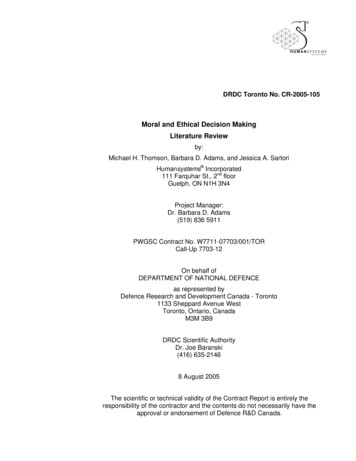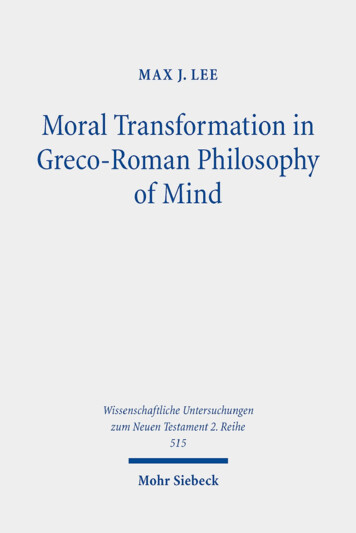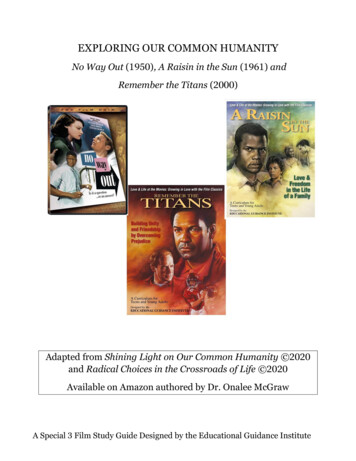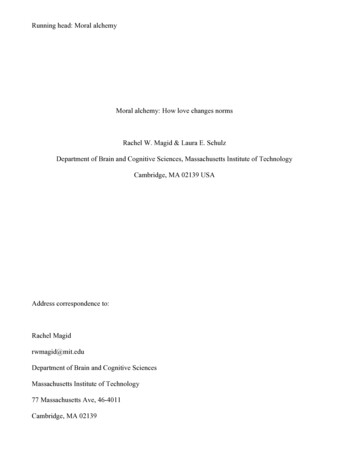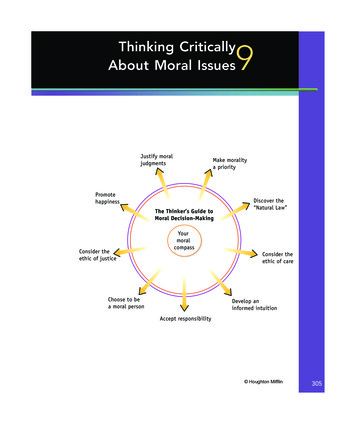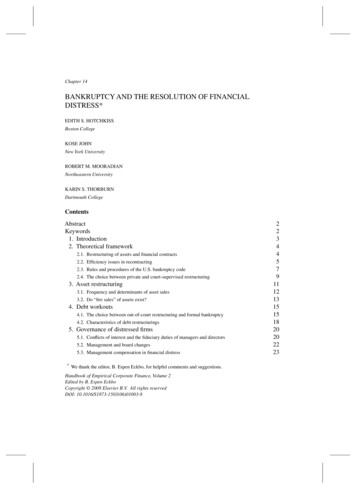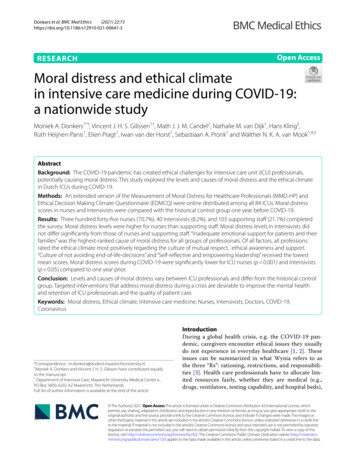
Transcription
(2021) 22:73Donkers et al. BMC Med en AccessRESEARCHMoral distress and ethical climatein intensive care medicine during COVID‑19:a nationwide studyMoniek A. Donkers1*†, Vincent J. H. S. Gilissen1†, Math J. J. M. Candel2, Nathalie M. van Dijk1, Hans Kling3,Ruth Heijnen‑Panis1, Elien Pragt1, Iwan van der Horst1, Sebastiaan A. Pronk1 and Walther N. K. A. van Mook1,4,5AbstractBackground: The COVID-19 pandemic has created ethical challenges for intensive care unit (ICU) professionals,potentially causing moral distress. This study explored the levels and causes of moral distress and the ethical climatein Dutch ICUs during COVID-19.Methods: An extended version of the Measurement of Moral Distress for Healthcare Professionals (MMD-HP) andEthical Decision Making Climate Questionnaire (EDMCQ) were online distributed among all 84 ICUs. Moral distressscores in nurses and intensivists were compared with the historical control group one year before COVID-19.Results: Three hundred forty-five nurses (70.7%), 40 intensivists (8.2%), and 103 supporting staff (21.1%) completedthe survey. Moral distress levels were higher for nurses than supporting staff. Moral distress levels in intensivists didnot differ significantly from those of nurses and supporting staff. “Inadequate emotional support for patients and theirfamilies” was the highest-ranked cause of moral distress for all groups of professionals. Of all factors, all professionsrated the ethical climate most positively regarding the culture of mutual respect, ethical awareness and support.“Culture of not avoiding end-of-life-decisions” and “Self-reflective and empowering leadership” received the lowestmean scores. Moral distress scores during COVID-19 were significantly lower for ICU nurses (p 0.001) and intensivists(p 0.05) compared to one year prior.Conclusion: Levels and causes of moral distress vary between ICU professionals and differ from the historical controlgroup. Targeted interventions that address moral distress during a crisis are desirable to improve the mental healthand retention of ICU professionals and the quality of patient care.Keywords: Moral distress, Ethical climate, Intensive care medicine, Nurses, Intensivists, Doctors, COVID-19,Coronavirus*Correspondence: m.donkers@student.maastrichtuniversity.nl†Moniek A. Donkers and Vincent J. H. S. Gilissen have contributed equallyto the manuscript.1Department of Intensive Care, Maastricht University Medical Center ,PO Box 5800, 6202 AZ Maastricht, The NetherlandsFull list of author information is available at the end of the articleIntroductionDuring a global health crisis, e.g. the COVID-19 pandemic, caregivers encounter ethical issues they usuallydo not experience in everyday healthcare [1, 2]. Theseissues can be summarized in what Wynia refers to asthe three “Rs”: rationing, restrictions, and responsibilities [3]. Health care professionals have to allocate limited resources fairly, whether they are medical (e.g.,drugs, ventilators, testing capability, and hospital beds), The Author(s) 2021. Open Access This article is licensed under a Creative Commons Attribution 4.0 International License, whichpermits use, sharing, adaptation, distribution and reproduction in any medium or format, as long as you give appropriate credit to theoriginal author(s) and the source, provide a link to the Creative Commons licence, and indicate if changes were made. The images orother third party material in this article are included in the article’s Creative Commons licence, unless indicated otherwise in a credit lineto the material. If material is not included in the article’s Creative Commons licence and your intended use is not permitted by statutoryregulation or exceeds the permitted use, you will need to obtain permission directly from the copyright holder. To view a copy of thislicence, visit http:// creat iveco mmons. org/ licen ses/ by/4. 0/. The Creative Commons Public Domain Dedication waiver (http:// creat iveco mmons. org/ publi cdoma in/ zero/1. 0/) applies to the data made available in this article, unless otherwise stated in a credit line to the data.
Donkers et al. BMC Med Ethics(2021) 22:73structural (e.g., venue) or human (e.g., medical personnel) [4]. Restrictions such as isolation and quarantiningof patients, their families and health care professionalsmay additionally affect the delivery of health care [5].Furthermore, healthcare professionals are held responsible for the quality of care for their patients despitetheir personal risks. As a consequence, these professionals have to balance their own and their loved ones’physical and mental health needs with those of theirpatients.As the need for intensive care treatment and supporthas rapidly increased during the COVID-19 pandemic,the ethical issues described above may apply in particularto the intensive care unit (ICU) professionals. This maycause some to experience so-called “moral distress”.The term moral distress is defined as knowing what todo in an ethical situation, but being constrained in someway from doing this [6]. An important contributor thateither alleviates or aggravates moral distress in healthcare professionals is the ethical climate in their units andorganization. Several researchers in health care settingsidentified that the more positive the ethical climate isperceived, the less moral distress is reported [7–9].Studies examining moral distress and ethical climate inhealthcare professionals have found that both are associated with the intention to leave one’s job [10–20]. In2019, a questionnaire study in 84 intensive care units inthe Netherlands already revealed that nurses and intensivists experience high levels of moral distress in dailyclinical practice (14.9% and 7.5% respectively) [21]. Thismay be compounded during the COVID-19 pandemic.Experience with previous epidemic health emergencieshas shown that distress during an outbreak can causelong-term psychological effects on healthcare professionals such as anxiety, post-traumatic stress disorder, anddepression [22–28].Several studies have investigated the mental healthstate and factors contributing to burnout of health careprofessionals exposed to the COVID-19 disease [29–34].Recently, a study conducted among ICU professionals ina Dutch university medical center and teaching hospitalidentified three issues that became significantly more distressing during COVID-19 compared to one year prior:scarcity of resources, time, and/or staff, and having towork with colleagues believed insufficiently skilled and/or work unsafely. Despite their interesting findings, anational study is so far lacking [35].Consequently, this study aims to assess levels of moraldistress and quality of ethical climate experienced byintensive care professionals in the Netherlands duringthe COVID-19 pandemic and to determine factors thatcause moral distress in these health care professionals.Furthermore, this study aims to compare the degree ofPage 2 of 12moral distress during the COVID-19 outbreak with thoseof a cohort one year before the COVID-19 outbreak.MethodThis study was performed between April and June 2020,among all 84 ICUs in the Netherlands. This was just afterthe first, and so far largest peak of 1320 COVID-19 (suspected) patients admitted to the ICU in the Netherlandson April 7th. By June 11th, the end of the study period,this number had been reduced to 115 patients [36].ParticipantsAll ICU team managers were asked to distribute anonline questionnaire by email to intensivists, ICUnurses, and supporting staff (all personnel from otherdepartments called upon, but not primarily trainedto deliver ICU care) working in the ICU during theCOVID-19 pandemic. Intensivists and ICU nurses werealso approached by email through their representativeorganizations (the Dutch Association for Intensive Careand the Dutch Intensive Care Association for Nurses &Healthcare Assistants respectively). At the time of thestudy, 3800 ICU-nurses and 826 intensivists were working in the Dutch ICUs, with 63.8% male and 36.2% femaleintensivists. The number of supporting staff deployedin the Dutch ICUs was unknown. For intensivists, theage distribution was as follows: 30–39 years: 12.5%;40–49 years: 44.9%; 50–59 years: 31.7% and 60–69 years:10.9%. The age and gender distribution was unknown forICU nurses.Ethical approval, informed consent, data analysisThis study was approved by the Central COVID-19Research Committee and the Board of Directors ofMaastricht University Medical Centre. Participation wasstrictly voluntary, and no incentives were offered. Participants were provided an information letter and were onlyable to participate after providing written informed consent. Data were collected via an online survey software,Qualtrics [37], and were securely stored and analysedaccording to the General Data Protection Regulation.Data could not be traced back to specific participants.QuestionnaireThe questionnaire included the Measure of Moral Distress for Healthcare Professionals (MMD-HP) [38], theethical decision-making climate questionnaire (EDMCQ)[39], and demographic questions. Twenty items that specifically related to the COVID-19 pandemic were addedto the questionnaire. A copy of the questionnaire is provided in Additional file 1.
Donkers et al. BMC Med Ethics(2021) 22:73MMD‑HPThe MMD-HP consists of 27 different clinical situationsand an option to suggest other clinical situations of moraldistress. Each item was rated on a five-point Likert scalefor the frequency of occurrence (0 never; 4 very frequently) and the level of distress (0 none; 4 very distressing). The moral distress score of each item resultedfrom multiplying frequency of occurrence and level ofdistress (range 0–16). After every page break, a comment field was added to allow respondents to clarify theirresponses. The MMD-HP furthermore contains questions about resignation due to moral distress, providingservices that address moral distress and suggestions onhow to reduce moral distress. The MMD-HP was backand forth translated from English to Dutch.EDMCQThe EDMCQ consists of 32 items to assess the ethical climate in the ICU context in the domains of team climate,leadership by physicians, and end-of-life (EOL) care. Theoriginal Dutch version of the EDMCQ was used. Eachitem was scored on a five-point Likert scale from stronglydisagree to strongly agree. A comment field was addedafter each domain.Development of COVID‑19 related itemsThe previously validated MMD-HP was extended by adding eight items regarding specific COVID-19 aspects,such as family and patient support and contamination fear. Also, twelve items were added to the originalEMDCQ questionnaire. To compile these extra questions, an initial pool of questionnaire items was generatedbased on the available literature [40–43]. Relevance andpossible difficulties of comprehensibility or interpretation of the added items were discussed in an expert panelconsisting of ICU-professionals. Items were adjusted ordiscarded if deemed necessary. The questionnaire wassubsequently distributed among the participants, no pilotstudy was performed. However, Cronbach’s alpha calculated for the items added to the MMD-HP and EDMCQevidenced a rather high internal consistency (0.85 and0.87 respectively). Exploratory factor analysis (EFA) ofthe extended MMD-HP and extended EDMCQ wasperformed (see analysis). Additional factors with highinternal consistencies emerged from the extra items,indicating an added value of the extra items. See Additional files 2 and 3.AnalysisQuantitative analysisQuantitative data were analysed using SPSS v25.0.0.1[44]. The chi-square goodness-of-fit-test was conductedPage 3 of 12to assess whether the respondents are representative forthe entire population of ICU professionals. The distribution of age and gender of the intensivist group was compared with the numbers expected based on the nationaldistribution. A non-response bias analysis for ICU nursesand supporting staff could not be performed due to thelack of available national data.Exploratory factor analysis (EFA) was performed toidentify the underlying constructs between item scores inthe extended MMD-HP and EDMCQ, and thus to checkthe construct validity of the scales. Principal axis factoring was conducted on the 35 items with oblique rotation.The number of factors to be retained was determined byusing the Kaiser Criterion and the scree plot. The factorswere interpreted by examining the pattern matrix. Onlythose items correlating 0.30 or higher with a factor in therotated solution were considered to be associated withthat factor. The score for each factor was calculated bysumming the item scores (frequency times level of distress) of the items associated with a factor and dividingthis sum by the number of items per factor. EFA of theextended EDMCQ was conducted in the same manner, aswell as the calculation of the factor scores, except that nomultiplication was needed to obtain the item scores. Theidentified factors and factor loadings per item are provided in Additional file 2. The internal consistency of thesets of items associated with the identified factors of theextended MMD-HP and extended EDMCQ was measured by Cronbach’s alpha, which ranged from acceptableto very good and from good to very good respectively.The internal consistency was also very good for all itemsof the original and extended MMD-HP, as well as for allitems of the original and extended EDMCQ. More detailscan be found in Additional file 3.Descriptive statistics were calculated for demographics and answers to each additional question. Comparisons between intensivists, ICU nurses and supportingstaff on continuous variables were made using Analysisof Variance (ANOVA) with Games Howell post hoc teststo correct for multiple testing. The Pearson correlationcoefficient was calculated to measure the strength anddirection of the association between moral distress levelsand several continuous variables expected to be relatedto moral distress. When testing these Pearson correlations, the Bonferroni method was used to correct formultiple testing. Since seven correlations were examined,overall and for each profession, the associated p-valueswere inflated by multiplying these by 7.Comparison with the historical control groupOne year before COVID-19, a nationwide moral distress study using the original MMD-HP was conductedamong all ICU-nurses and intensivists working in the
Donkers et al. BMC Med Ethics(2021) 22:73Netherlands, of whom 120 intensivists (18.7%) and 499ICU nurses (10.1%) in the Netherlands completed thequestionnaire [21]. In the current study, moral distressoutcomes and the highest-ranking moral distress itemsof the original MMD-HP of intensivists and ICU nurseswere compared with this historical control group usingindependent samples t tests.Page 4 of 12Moral distressOverall moral distress level per professionMoral distress levels were higher for nurses than forsupporting staff. Moral distress levels in intensivists didnot differ significantly with those of nurses and supporting staff. See Table 2.Exploratory factor analysisQualitative analysisParticipants were able to provide narrative commentary by responding to the open-ended questionsand comment fields in the questionnaire, which wasanonymized down to the subgroup level. Data wereanalysed using ATLAS.ti v8.4.18 [45]. Qualitative datawere analysed independently by two researchers (MDand SP), both medical students. An inductive thematicanalysis with the widely accepted six-step process wasused to explore deeper themes within the data [46].First the researchers familiarised themselves with thedata (step 1) and generated initial codes (step 2). Fromthese codes common and relevant themes were identified (step 3). Units of comments consisting of onegrammatical clause, yet covering different topics werecoded as different units. Initial codes were subsumedinto more abstract categories, which were eventuallycollapsed into core-categories using a constant comparative approach (step 4). A codebook was formulated after reaching consensus, which was then usedto independently recode the data (step 5). Full codingwas initially done by one researcher (MD), while randomly selected parts were double-coded by one otherindependent researcher (SP). Codes were modified ifconsidered necessary. The pre-final analysis was thenchecked and any disagreements in coding were resolvedby discussion among members of the research teamuntil consensus was reached. Finally, step six of the thematic analysis was completed: reporting the findings.This study was reported according to the Standards forReporting Qualitative Research [47].ResultsDemographic dataThe extended MMD-HP was completed by 41 intensivists (5.0%), 355 ICU nurses (9.3%), and 108 supportingstaff, the extended EDMCQ by 40 intensivists (4.8%), 345ICU nurses (9.1%), and 103 supporting staff. Every itemwas completed for every survey returned. Distributionof gender and age in the intensivist group did not differsignificantly from the national population (p 0.71 andp 0.07 respectively). An overview of the participants’characteristics is given in Table 1.EFA of the extended MMD-HP revealed seven factors(see Table 2) which explained 58.8% of the variance.The factor “Inadequate emotional support forpatients and their families” was considered most morally distressing by all professions (see Table 2). Of theindividual items in this factor, the items “Being unableto provide patients and their families optimal emotional support” and “Being unable to allow patients andtheir families to have a dignified farewell” received thehighest mean scores in all professions (see Table 3).“Fear of contamination” was also experienced as relatively highly morally distressing by all professions. Thehighest scoring item in this factor in all professionalswas “Feeling obligated to provide care to patients wherethe health of my loved ones is at risk”.The mean factor score of “Suboptimal patient caredue to organizational restrictions” was particularly highfor ICU nurses. “Being required to work with otherhealthcare team members who are less experiencedthan patient care requires” and “Being required to carefor more patients than I can safely care for” were thehighest scoring items in this factor. An overview ofitems with the highest and lowest scores per factor perprofession are shown in Additional file 4.Qualitative commentsAmong the 207 qualitative comments regarding theextended MMD-HP, most were related to workingwith non-standard equipment and resources (16%) andthe inability to provide psychosocial care to patientsand their families (14%). For example, one ICU nursecommented:Sometimes I had to beg if the family could visit whenthe patient was so ill that discontinuing treatmentwas considered. Rules were regularly eased, but notthis rule. (ICU nurse)ICU nurses in particular frequently reported dilemmasconcerning the shortage of nursing staff. Among the 106comments from ICU nurses, 18 related to a suboptimallevel of competence of colleagues and 14 to the highnumber of patients they had to care for. Other frequentlyreported comments from ICU nurses concerned poor
Donkers et al. BMC Med Ethics(2021) 22:73Page 5 of 12Table 1 Demographics of participantsNurse (n 355)Intensivist (n 41)Supportingstaff(n 108)SexMale81 (22.8%)25 (61.0%)18 (16.7%)Female274 (77.2%)16 (39.0%)90 (83.3%)Mean age43.64 (11.4)45.78 (6.7)40.17 (10.4)40 (11.3%)0 (0.0%)18 (16.7%)Age categories 3030–49177 (73.2%)30 (73.2%)65 (60.2%) 50138 (38.9%)11 (26.8%)25 (23.1%)Hospital typeTertiary, academic32 (9.0%)10 (24.4%)4 (3.7%)Top referral189 (53.2%)20 (48.8%)77 (71.3%)Secondary center131 (36.9%)11 (26.8%)27 (25.0%)Total years of work experience 568 (19.2%)8 (19.5%)38 (35.8%)5–19153 (43.1%)31 (75.6%)46 (43.4%) 20134 (37.7%)2 (4.9%)22 (20.8%)Years of work experience on current workplace 587 (25.5%)14 (35.9%)45 (42.9%)5–19165 (48.4%)23 (59.0%)43 (41.0%) 2089 (26.1%)2 (5.1%)17 (16.2%)Normal ICU-bed count 1047 (13.3%)7 (17.1%)7 (6.7%)10–29193 (54.7%)16 (39.0%)92 (87.6%) 30113 (32.0%)18 (43.9%)6 (5.7%)ICU-Bed count during COVID-19 1015 (4.3%)0 (0.0%)4 (3.8%)10–2986 (24.5%)9 (22.0%)27 (25.5%) 30250 (71.2%)32 (78.0%)75 (70.8%)Percentage increase in bed count 20%48 (13.7%)3 (7.3%)19 (18.3%)20–49%95 (27.1%)6 (14.6%)14 (13.5%)50–79%107 (30.5%)16 (39.0%)19 (18.3%) 80%101 (28.8%)16 (39.0%)52 (50.0%)communication about rules, regulations and guidelinesby their supervisors (n 18). One nurse wrote:Regulations are sometimes changed per half-day. Itis impossible to keep up. (ICU nurse)Associations between moral distress, ethical climateand respondents’ characteristicsResponse-percentages of each professional group peradditional question are provided in Additional file 5.Higher moral distress scores were associated with lowerethical climate scores in ICU nurses (r 0.55, p 0.001)and supporting staff (r 0.47, p 0.001). No significantcorrelation was found for intensivists. As shown inTable 4, ICU professionals who considered quitting theirposition reported significantly higher moral distressscores than those who did not (p 0.001). Higher moraldistress scores were likewise seen in participants considering using psychosocial help (p 0.001) and in participants who indicated that the attention paid to moraldistress was insufficient (p 0.001). A greater number ofICU beds was significantly correlated with higher moraldistress scores in ICU nurses (r 0.21, p 0.001), but notfor intensivists or supporting staff. No statistically significant correlation was found for moral distress regardingage and work experience for all professions.
Donkers et al. BMC Med Ethics(2021) 22:73Page 6 of 12Table 2 Moral distress score and standard deviation per profession with Games–Howell correction for differences betweenprofessionsMean (SD)aOverall moral distress scorep valueNurse (n 355)Intensivist (n 41)2.97 (2.06)2.56 (1.38)Support‑ing staff(n 108)2.09 (1.71)N–IbN–ScI–Sd0.22 0.0010.190.40Factors1. Suboptimal patientcare due to organizational restrictions5.01 (3.45)3.34 (2.39)2.77 (2.51) 0.001 0.0012. Inadequate emotional support for patients and their families5.73 (3.89)6.20 (3.27)4.63 (3.91)0.670.030 0.053. Fear of contamination3.86 (4.28)3.59 (3.86)3.77 (3.86)0.910.980.974. Collaboration with patients and their families1.54 (1.75)1.53 (1.29)0.78 (1.11)1.00 0.001 0.055. Culture of fear and hierarchy0.85 (1.54)1.03 (1.31)0.53 (0.91)0.69 0.05 0.056. Administrative burden2.96 (3.61)2.43 (2.63)2.07 (2.82)0.47 0.050.767. Disproportional and aimless care2.68 (2.76)1.83 (1.55)1.49 (1.77)0.010 0.0010.50aScore range 0–16 (higher scores reflect more moral distress)bNurse vs. intensivistcNurse vs. supporting staffdIntensivist vs. supporting staffTable 3 Highest ranking moral distress situations across nurses for the extended MMD-HPNurses (n 355)Intensivists(n 41)Supporting staff(n 108)Item no ItemMean (SD)a Rank Mean (SD) Rank Mean (SD) Rank p value30Be unable to provide optimal emotional support to anxious anddistressed patients/family members7.69 (5.31)17.22 (4.64)25.38 (5.23)2 0.00129Be unable to allow patients/family members to have a dignifiedfarewell7.00 (5.43)28.02 (4.87)16.55 (5.25)10.3213Be required to work with other healthcare team members who areless experienced than patient care requires6.57 (4.94)33.32 (3.45)102.59 (3.57)12 0.00116Be required to care for more patients than I can safely care for6.22 (4.19)43.05 (3.99)132.42 (4.19)13 0.00128Working with other healthcare team members whom I do notknow well6.00 (4.61)52.54 (2.97)154.81 (4.28)3 0.00117Experience compromised patient care due to a lack of resources/equipment/bed capacity5.23 (4.97)66.10 (5.25)33.38 (4.23)70.0019Watch patient care suffer because of a lack of provider continuity5.00 (4.65)73.83 (3.67)73.10 (3.88)9 0.00135Providing care to patients of whom the course of the disease andproper treatment is unclear4.38 (4.24)85.46 (4.76)44.54 (4.94)40.3332Feeling obligated to provide care to patients, where the health ofmy loved ones is at risk4.30 (5.10)94.22 (4.87)54.37 (4.86)50.99aScore range 0–16 (higher scores reflect more moral distress)Services addressing moral distressMost participants (93.4%) declared that services providing support for moral distress were implementedduring COVID-19. A total of 764 narrative commentswere received to the question what services wereprovided to address moral distress. The provisionof professional moral distress support was most frequently reported (60%), e.g., support by psychologists,social workers, spiritual counsellors, peer supporters, and other mental health support team members.Furthermore, an “open” culture in which managersare approachable and professional problems and feelings or emotions could be shared with colleagues wasfrequently mentioned (18%). Debriefing as an intervention was also reported by all professions (15%),sometimes in the presence of a psychosocial supportworker.
Donkers et al. BMC Med Ethics(2021) 22:73Page 7 of 12Table 4 Associations between moral distress and respondents’characteristicsVariablen (%)Not considering leaving job nowa470 (93.1) 2.57 (1.80)Considering leaving job now35 (6.9)Enough attention is paid to moral distressb410 (81.7) 2.44 (1.72)Not enough attention is paid to moral distress 92 (18.3)Moraldistressscore (SD)5.03 (2.63)4.10 (2.37)Not considering using psychosocial help nowc 450 (93.8) 2.65 (1.92)Considering using psychosocial help nowa30 (6.3)4.05 (2.25)Not considering leaving now vs. considering leaving now (p 0.001)bEnough attention is paid vs. not enough attention is paid (p 0.001)cNot considering using help now vs. considering using help now (p 0.001)Suggestions regarding the reduction of moral distressOf all respondents, 18.4% indicated that the attention paid to addressing moral distress was insufficient.Respondents provided 154 suggestions how to addressmoral distress. Some suggested to make psychosocialsupport more accessible and individually tailored and tocontinue offering this support after the crisis is over, asone supporting staff member describes:Aftercare will be necessary. We now find ourselves inthe eye of the storm. When the worst is over, we willrealize what happened.Others proposed to improve mutual respect and supportwithin the team by showing more appreciation by thesupervisor and sharing experiences and feelings. Furthermore, respondents suggested to organize more frequentevaluations and to improve interdisciplinary shared decision making, for example by increasing involvement ofnurses in decision making.Too little attention was paid to relevant questionsfrom the nursing ward. There was a clear top-downatmosphere, probably due to time constraints. I feltmy voice was not being heard, even though my usualfocus is infection prevention. (ICU nurse)Some described how working conditions should beimproved. Some ICU nurses for example called uponfinancial investments from the government to improveworking conditions. Respondents furthermore describedhow they wanted to be able to provide better psychosocial care to patients and their families.There should be more room for families to visitpatients, by providing more and better protectivemeasures. Better contact and more dignified patientcare would reduce much moral distress. (ICU nurse)Ethical climateExploratory factor analysisEFA of the extended EDMCQ revealed eight factors,which explained 61.8% of the variance.Ethical climate per professionWhile the ethical climate factor scores of ICU nurses andsupporting staff were mostly comparable, intensivistshad significantly higher ethical climate scores on all factors except for “Practice and culture of ethical awarenessand support”. “Practice and culture of ethical awarenessand support” and “Culture of mutual respect within theinterdisciplinary team” were the highest perceived ethicalclimate factors in all professions. “Culture of not avoidingend-of-life-decisions” and “Self-reflective and empowering leadership” received the lowest mean scores (seeTable 5). “Patients with little chance of recovery are notfrequently admitted” and “Physicians in charge dare toshow their vulnerability” were the lowest scoring ethicalclimate items in all professions. Additional file 6 showsthe lowest ranking ethical climate items in the extendedEMDCQ per profession.Qualitative commentsFrom the 504 respondents 157 narrative comments tothe open ended questions relating to the ethical climatewere received, respectively by 133 ICU nurses, 8 intensivists and 36 supporting staff. Comments concerning teamclimate (n 42) were mainly related to the themes of alack of interdisciplinary shared decision making (48%), asillustrated below:Nurses no longer participate in the multidisciplinaryconsultation. No ifs or buts, just work! (ICU nurse)Also, a lack of reflective practice (21%), and feelingundervalued (17%) were often mentioned in the contextof the team climate.While 18% of the comments on leadership culture(n 37) indicated satisfaction, some described hierarchy(22%).We are not equals certainly not in a crisis situation. (ICU nurse)Others found there was a lack of self-reflective and firmleadership (10%).The problems regarding psychosocial health (n 46)that participants most frequently reported were fatigue(56%) and sleeping difficulty (36%), as one described:
Donkers et al. BMC Med Ethics(2021) 22:73Page 8 of 12Table 5 Ethical climate score per profession per factor with Games–Howell correction for differences between professionsOverall ethical climate scoreMean (SD)aP-valueNurse (n 345) Intensivist (n 40) Supportingstaff(n 103)N–Ib3.90 (0.54)4.11 (0.38)3.89 (0.43) 0.05N–ScI–Sd0.96 0.05Factor1. Practice and culture of ethical awareness and support4.34 (0.59)4.23 (0.60)4.23 (0.62)0.562. Self-reflective and empowering leadership by phy
scores in nurses and intensivists were compared with the historical control group one year before COVID‑19. Results: Three hundred forty‑ve nurses (70.7%), 40 intensivists (8.2%), and 103 supporting sta (21.1%) completed the survey. Moral distress levels were higher for nurses than supporting sta. Moral distress levels in intensivists did
